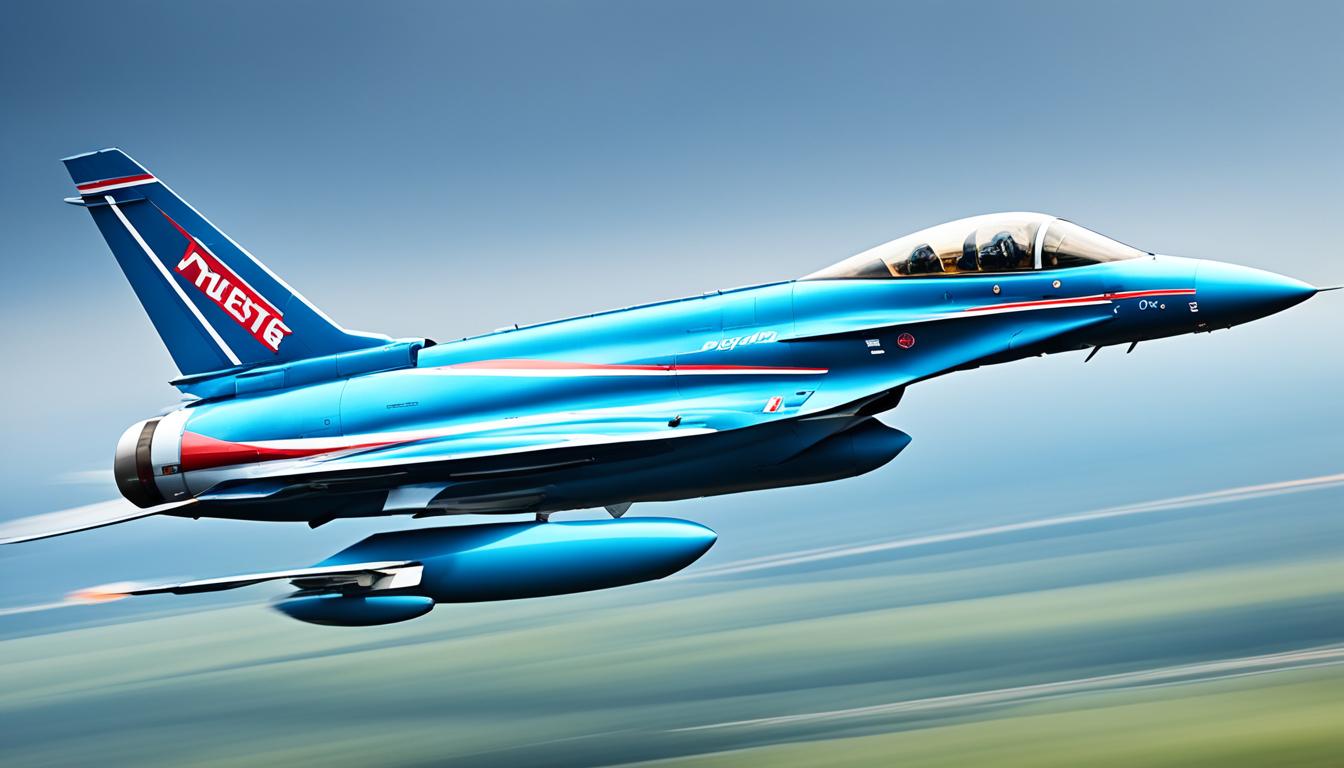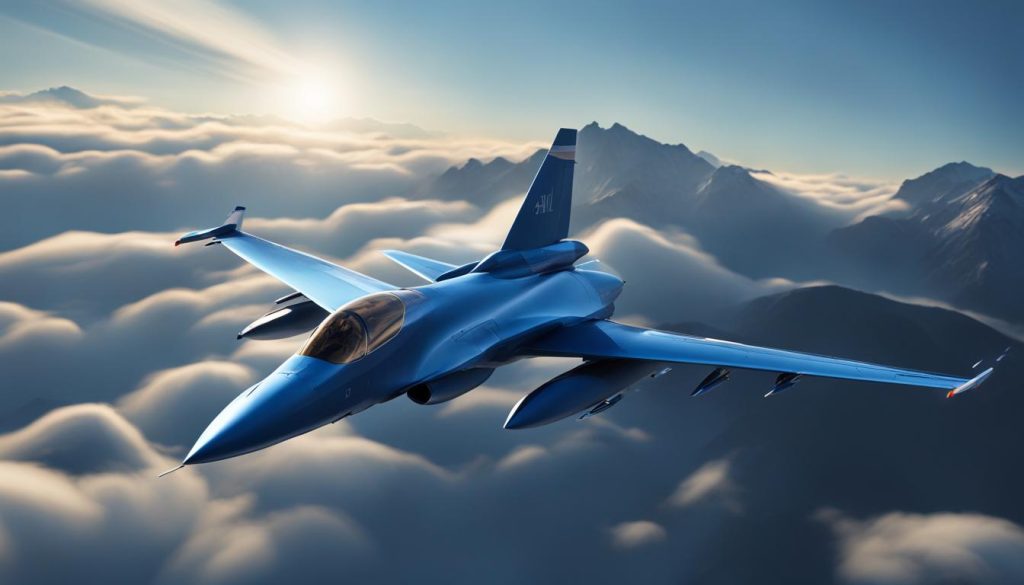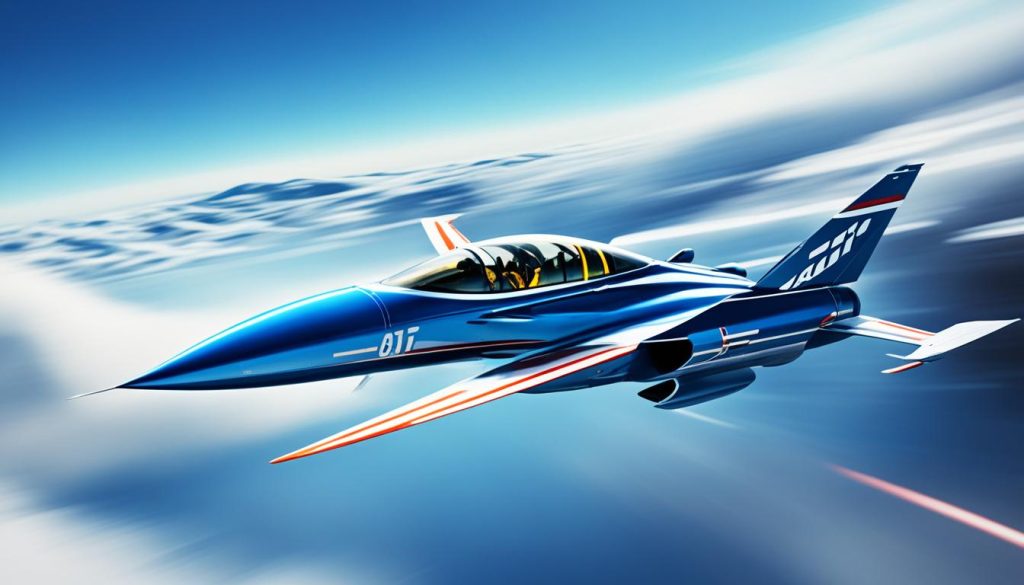
How Fast Does a Jet Travel? Uncover Speeds Now
When it comes to the speed of jets, curiosity is only natural. Whether you are planning a trip or simply fascinated by aircraft, understanding jet speed can provide valuable insights. From commercial jets to private airplanes, each type of aircraft has its own maximum velocity.
Commercial jets, known for their efficiency and reliability, typically cruise at speeds between 500 to 600 miles per hour (800 to 970 kilometers per hour). These high-speed jets allow for rapid travel, connecting people and places across the globe.
However, the world of aviation doesn’t stop there. Military jets take speed to a whole new level. These powerful machines can reach supersonic speeds exceeding 1,000 mph (1,609 kph), demonstrating their exceptional capabilities.
Private jets, on the other hand, offer a combination of luxury and speed. Some models even surpass the speed of commercial jets, ensuring swift and comfortable travel for discerning passengers.
So, how fast does a jet travel? Let’s dive into the details and explore the fascinating world of jet speed.
Key Takeaways:
- Commercial jets typically cruise at speeds between 500 to 600 mph (800 to 970 kph).
- Military jets can reach supersonic speeds exceeding 1,000 mph (1,609 kph).
- Private jets offer impressive speeds, with some models exceeding the speed of commercial jets.
- The speed of a jet is influenced by factors such as weather conditions, flight altitude, and the streamlined shape of the aircraft.
- Understanding jet speed can help in choosing the right aircraft for your travel needs.
The Fastest Private Jets in the World
When it comes to private jets, speed is a key factor for discerning travelers who want to reach their destinations quickly and efficiently. In this section, we will explore the fastest private jets in the world and their impressive speeds.
At the top of the list is the NASA/USAF X-15, which holds the record for the fastest private jet speed. This remarkable aircraft can reach speeds of Mach 6.72 or approximately 4,500 miles per hour, making it the epitome of high-speed private jets.
Another notable mention is the MiG-25 Foxbat, which is recognized as the fastest military jet. It boasts a speed of Mach 3.2, equivalent to 2,190 miles per hour, emphasizing its impressive velocity.
Within the realm of private jets, the Cessna Citation X+ stands out as a powerhouse of speed. With a maximum speed of Mach 0.935 or approximately 536 knots, it offers a remarkable private jet mph to satisfy even the most time-conscious travelers.
Other fast private jets that deserve recognition include the Gulfstream G650ER, Bombardier Global 6000, and Gulfstream G500, each with their own impressive private jet speeds.
| Private Jet | Maximum Speed |
|---|---|
| Cessna Citation X+ | Mach 0.935 or approximately 536 knots |
| Gulfstream G650ER | Maximum high-speed cruise of Mach 0.925 |
| Bombardier Global 6000 | Mach 0.89 or approximately 513 knots |
| Gulfstream G500 | Mach 0.925 or approximately 576 knots |
As the table above illustrates, these private jets offer unmatched performance and speed, allowing passengers to travel with unrivaled efficiency and luxury.
Factors Affecting Jet Speed
The speed of a jet can be influenced by various factors, which play a crucial role in determining its velocity. Understanding these factors is essential to comprehend the impact they have on jet speed. Let’s explore the determinants that affect the speed of a jet:
- Weather Conditions: Weather conditions, such as wind speed and direction, can significantly impact the speed of a jet. Headwinds have a decelerating effect on the aircraft, while tailwinds can propel it forward, increasing its speed.
- Headwinds and Tailwinds: Headwinds, which oppose the aircraft’s forward motion, can create resistance and reduce its speed. Conversely, tailwinds, which blow in the same direction as the aircraft’s movement, can provide a boost, increasing its velocity.
- Flight Altitude: The altitude at which a jet operates influences its speed. Higher altitudes generally offer less air resistance, allowing the jet to achieve higher speeds due to reduced drag.
- Streamlined Shape of the Aircraft: The aerodynamic design and streamlined shape of an aircraft can significantly minimize air resistance, enhancing its speed. Private jets, known for their sleek and optimized design, have a distinct advantage in terms of reducing drag compared to commercial jets.
- Measuring Units Used for Speed: The choice of measuring units for speed can affect the perception of jet speed. Different units, such as miles per hour (mph) or knots, can present varying numerical values while referring to the same velocity. Therefore, it is essential to understand the units used when comparing jet speeds.
To visually understand how these factors affect jet speed, refer to the table below:
| Factors | Effect on Jet Speed |
|---|---|
| Weather Conditions | Varies based on wind speed and direction. Headwinds can slow down the jet, while tailwinds can increase its speed. |
| Headwinds and Tailwinds | Headwinds oppose the forward motion and reduce speed, while tailwinds provide a boost, increasing velocity. |
| Flight Altitude | Higher altitudes offer less air resistance, enabling the jet to achieve higher speeds due to reduced drag. |
| Streamlined Shape of the Aircraft | Aerodynamic design minimizes air resistance, positively impacting the jet’s speed. |
| Measuring Units Used for Speed | The choice of units affects the numerical representation of speed when comparing different jets. |
Private vs. Commercial Jet Speeds
When it comes to jet speed, there’s often a comparison between private jets and commercial jets. While commercial jets are renowned for their impressive speeds, private jets are no slouch either. Let’s explore the speed capabilities of both and see how they compare.
Private Jet Speed
Private jets have come a long way in terms of speed. While they may not match the velocity of military fighter jets, many private jets can still reach remarkable speeds. Take, for example, the Cessna Citation X+ which can soar up to a maximum speed of 717 mph. This speed closely approaches the capabilities of commercial aircraft.
Commercial Jet Speed
Commercial jets, on the other hand, cruise at speeds that typically range around 500 to 600 mph. These speeds allow for efficient long-distance air travel, making them the preferred choice for journeys that require larger capacity and improved fuel efficiency.
A Speed Comparison
To provide a clear comparison, let’s put the private jet speed and the commercial jet speed side by side:
| Jet Type | Speed Range (mph) |
|---|---|
| Private Jet (Cessna Citation X+) | Up to 717 |
| Commercial Jet | Average speeds of 500-600 |
As you can see from the comparison, private jets can reach similar speeds to their commercial counterparts. However, it’s important to consider that commercial jets are built for long-distance travel and are designed to accommodate a larger number of passengers, making them a more efficient choice for mass transportation.
While private jet speed is impressive for smaller groups or individuals traveling shorter distances, commercial jets still hold the advantage for long-haul flights under normal circumstances.
In the next section, we’ll explore how weather conditions can impact jet speed and what role headwinds play in aircraft speed.
How Weather Impacts Jet Speed
Weather conditions play a crucial role in determining the speed at which a jet can travel. Strong headwinds or turbulence can have a significant impact on the speed and performance of an aircraft. In adverse weather conditions, airplanes tend to slow down to ensure the safety of passengers and crew. The impact of weather on jet speed is a vital consideration for pilots and flight operators.
In contrast, favorable weather conditions can have the opposite effect. Jets can cover the same distance in a shorter duration when they encounter tailwinds, which are winds blowing in the same direction as the aircraft’s flight path. Tailwinds can provide a speed boost, allowing jets to travel faster and reach their destinations more efficiently.
“Weather conditions are a crucial factor that pilots must navigate to ensure a smooth and efficient flight. Understanding how weather impacts jet speed allows pilots to adjust their flight plans accordingly.”
In addition to headwinds and tailwinds, other weather conditions such as temperature, humidity, and air density can also affect jet speed. Hot and humid conditions can reduce air density, leading to decreased engine performance and lower speeds. On the other hand, cold and dry air can increase engine efficiency and enable jets to achieve higher speeds.
Overall, weather conditions are a critical consideration in aviation. Pilots and flight operators closely monitor weather forecasts and adjust flight plans as necessary to ensure the safety and efficiency of air travel. Factors such as headwinds, tailwinds, temperature, and air density all contribute to the impact of weather on jet speed.
The Importance of Weather Forecasting
Accurate and timely weather forecasting is essential for pilots and aviation professionals. Meteorologists specialize in predicting weather conditions, including wind patterns, temperature changes, and atmospheric pressure. This information allows pilots to plan flights, choose optimal routes, and make informed decisions regarding jet speed and efficiency. Furthermore, flight operators rely on weather forecasts to ensure the safety and comfort of passengers.
The Role of Headwinds in Jet Speed
Headwinds can have a significant impact on the speed of a jet throughout various stages of its flight, including takeoff, cruising, and landing. The force of headwinds, which refers to winds blowing directly opposite to the aircraft’s direction of travel, alters the jet’s velocity and affects its overall performance and efficiency.
During takeoff and landing, headwinds can prove advantageous by providing an increased airflow against the aircraft’s wings. This increased airflow aids in generating the necessary lift, allowing jets to achieve the required velocity for takeoff more quickly. Furthermore, headwinds during landing assist in reducing the speed of the jet, making it easier to control and enabling shorter runway requirements.
While headwinds can create resistance and seemingly hinder the forward motion of the jet during cruising, their impact depends on the wind speed and the aircraft’s ability to counteract it. Pilots often adjust their flight plans in response to headwinds, calculating alternative routes or adjusting the altitude to achieve optimum speed and fuel efficiency.
Aircraft Performance and Headwinds
The influence of headwinds on the speed of a jet becomes particularly significant when considering the performance characteristics of different aircraft types. Some jets, such as private jets, tend to have smaller sizes and lighter weights compared to commercial airliners. As a result, they may be more susceptible to the effects of headwinds.
Commercial jets, designed with larger fuselages and more powerful engines, generally have greater capabilities to counteract headwinds and maintain their intended cruise speeds. Their robust structures and higher thrust-to-weight ratios enable them to push through headwinds with minimal reduction in speed.
| Jet Type | Average Cruise Speed (mph) | Impact of Headwinds |
|---|---|---|
| Commercial Jet | 550-600 | Minimal speed reduction |
| Private Jet | 500-600 | Speed reduction dependent on wind strength |
As shown in the table, headwinds can have a more noticeable impact on the speed of a private jet compared to a commercial jet. However, it is important to note that headwinds alone do not dictate the maximum speed or performance of an aircraft. Other factors such as altitude, weight, aircraft design, and engine power also contribute to the overall flight characteristics.
In light of the significant role that headwinds play in jet speed, pilots and air traffic controllers work together to monitor wind patterns and forecast headwinds. This allows for the efficient planning and coordination of flights, ensuring safe and timely departures and arrivals.
The Influence of Flight Altitude on Jet Speed
When it comes to the speed of jets, flight altitude plays a crucial role. Jets that fly at lower altitudes experience higher air pressure, which in turn affects their speed. This is because air density increases at lower altitudes, creating more resistance and making it more difficult for the aircraft to maintain higher speeds.
On the other hand, private jets have the advantage of being lighter and more maneuverable than commercial flights. This enables them to fly at higher altitudes, where air density is lower and there is less resistance. As a result, private jets are capable of achieving higher speeds compared to their counterparts flying at lower altitudes.
By taking advantage of the reduced air density at higher altitudes, private jets are able to optimize their performance and achieve faster speeds. This is particularly beneficial when traveling long distances, as higher speeds help reduce overall flight time and improve efficiency.
So, if speed is a priority for your travel needs, opting for a private jet that can fly at higher altitudes can provide you with the advantage of faster travel times.

Benefits of Flying at Higher Altitudes
- Reduced air resistance leading to faster speeds
- Improved fuel efficiency due to decreased drag
- Less traffic congestion compared to lower altitudes
- Access to more direct routes and shorter flight paths
“Flying at higher altitudes allows private jets to take advantage of reduced air density, enabling them to achieve higher speeds and optimize their performance.”
Streamlined Design and Jet Speed
The streamlined design of private jets plays a crucial role in their ability to achieve high speeds. By minimizing air resistance and reducing turbulence, a streamlined shape enhances aerodynamics, allowing these jets to maintain faster speeds compared to their bulkier counterparts.
When an aircraft has a streamlined design, it cuts through the air smoothly, minimizing drag and maximizing efficiency. The sleek contours and carefully crafted curves enable the jet to reduce resistance, which ultimately contributes to an increase in speed.
One of the key advantages of a streamlined design is the reduction of turbulence. Turbulence can slow down an aircraft as it encounters resistance from the air. However, with a streamlined shape, private jets can glide through the air with minimal disruption, maintaining a continuous and efficient flow of speed.
This efficient design feature allows private jets to achieve their remarkable jet speeds. Combined with their ability to fly at higher altitudes, where the air is less dense, private jets can capitalize on their streamlined design to reach impressive velocities.
Enhancing Efficiency with Streamlined Design
A streamlined design not only enables private jets to achieve high speeds but also enhances their overall efficiency. By reducing turbulence and minimizing resistance, these jets can optimize fuel consumption, extending their range and reducing costs.
Moreover, a streamlined design allows for smoother takeoffs and landings. With reduced drag, the aircraft can generate more lift, requiring shorter runways for both departure and arrival. This streamlined efficiency contributes not only to speed but also to the convenience of private jet travel.
The combination of aerodynamic superiority and higher speed capabilities makes private jets the preferred choice for individuals and businesses seeking fast, reliable, and efficient air travel.
“The streamlined design of private jets enhances their aerodynamics, reducing turbulence and allowing for higher speeds. This design feature plays a pivotal role in the overall speed and efficiency of these impressive aircraft.”
| Advantages of Streamlined Design | |
|---|---|
| Reduces air resistance | |
| Minimizes turbulence | |
| Enhances aerodynamics | |
| Improves fuel efficiency | |
| Allows for smoother takeoffs and landings |
Aircraft Speed Measuring Units Explained
When it comes to measuring the speed of an aircraft, various units are used to provide accurate calculations. Understanding these units is essential for pilots, engineers, and aviation enthusiasts alike.
There are three main aircraft speed measurements: calibrated airspeed, indicated airspeed, and true airspeed (TAS). Each measurement method serves a specific purpose and provides valuable information during flight.
Calibrated Airspeed (CAS)
Calibrated airspeed is the indication of an aircraft’s speed as measured by its airspeed indicator. It is adjusted to compensate for instrument errors and position errors due to the aircraft’s design. CAS is generally used for takeoff and landing calculations, as well as for ensuring safe and efficient operations within specific aircraft limitations.
Indicated Airspeed (IAS)
Indicated airspeed is the reading displayed on the aircraft’s airspeed indicator. It represents the pressure created by the aircraft’s forward motion and the surrounding air. IAS is used for general flight operations, including maintaining desired airspeeds during climb, descent, and level flight.
True Airspeed (TAS)
True airspeed is the actual speed at which an aircraft is moving through the air and is measured relative to undisturbed air mass. TAS takes into account factors such as altitude, temperature, and air density to determine the aircraft’s true velocity. It is the most accurate measurement of an aircraft’s speed and is commonly represented in knots, equivalent to one nautical mile per hour.
To calculate true airspeed, pilots use the indicated airspeed and correct for the differences in altitude and temperature. This conversion allows for precise navigation, fuel consumption calculations, and flight planning.
Understanding the various aircraft speed units is crucial for pilots to ensure safe and efficient operations during flight. From takeoff and landing calculations to fuel consumption and navigation, accurate speed measurement is essential for the successful operation of any aircraft.
The image above visually represents the concept of aircraft speed measurement, highlighting the correlation between calibrated airspeed, indicated airspeed, and true airspeed. It serves as a visual aid to further clarify the differences between these measurements.
Mach Number and Jet Speed
The Mach number is a crucial measure used to compare the speed of an aircraft to the speed of sound. It provides valuable insight into the velocity at which the aircraft is traveling and categorizes it as either subsonic or supersonic.
You may wonder what exactly Mach number signifies. Speeds below Mach 1 are considered subsonic, meaning they are slower than the speed of sound. On the other hand, speeds above Mach 1 are categorized as supersonic, indicating that the aircraft is traveling faster than the speed of sound.
When it comes to private jets, they typically operate at subsonic speeds. Mach numbers for private jets commonly range from 0.7 to 0.9, demonstrating their ability to travel efficiently without crossing into the supersonic realm.
| Category | Mach Number Range |
|---|---|
| Subsonic | Below Mach 1 |
| Supersonic | Above Mach 1 |
| Private Jets | 0.7 – 0.9 (subsonic) |
Understanding the Mach number is crucial for assessing the speed capabilities of different aircraft, ensuring efficient and safe travel for passengers. While private jets may not exceed the speed of sound, their subsonic speeds still allow for swift and comfortable journeys.

Did you know?
Chuck Yeager, an American pilot, became the first person to break the sound barrier in level flight while flying the Bell X-1 at a speed of Mach 1.06 in 1947.
Commercial Aircraft Speeds
When it comes to commercial aircraft speeds, large jets are known for their impressive cruising capabilities. During the cruise phase of a flight, these airplanes typically maintain speeds ranging from 550 to 580 miles per hour (880 to 930 kilometers per hour). This allows them to cover long distances efficiently and reduce total travel time for passengers.
However, it’s important to note that landing and takeoff speeds can vary significantly from the cruising speed. During these phases, most commercial jets fly at approximately 160 to 180 miles per hour (260 to 290 kilometers per hour). This slower speed allows for safer and smoother operation during critical moments of a flight.
| Aircraft Type | Cruising Speed (mph) | Cruising Speed (km/h) | Landing and Takeoff Speed (mph) | Landing and Takeoff Speed (km/h) |
|---|---|---|---|---|
| Boeing 747 | 570 | 920 | 180 | 290 |
| Airbus A320 | 530 | 850 | 160 | 260 |
| Boeing 777 | 560 | 900 | 170 | 270 |
Although commercial jets operate at high speeds, it’s important to prioritize safety and consider various factors such as weather conditions, air traffic control, and runway length when determining the appropriate landing and takeoff speeds. These speeds are optimized for optimal control and passenger comfort during critical flight phases.
Factors Impacting Commercial Aircraft Speeds
Commercial aircraft speeds are influenced by several factors such as:
- Altitude: Higher altitudes allow for smoother airflow and potentially higher speeds.
- Weather conditions: Strong headwinds or unfavorable weather conditions can affect the speed of a plane.
- Weight: The weight of the aircraft, including passengers and cargo, can impact its speed and performance.
- Aircraft design: The aerodynamic design of the plane plays a crucial role in minimizing drag and maximizing speed.
By optimizing these factors, airlines strive to achieve the most efficient and comfortable travel experience for their passengers.
“Commercial jets are engineering marvels, designed to transport passengers across the globe at incredible speeds while ensuring their safety and comfort.”
The Need for Efficient Flight Speeds
The speed at which commercial aircraft operate is determined by their efficiency. When it comes to flying, airlines have a delicate balance to maintain between fuel consumption and flight time. By optimizing their flight speeds, airlines can achieve efficient operations that result in more frequent departures and arrivals, ultimately maximizing their revenue.
Efficient flight speeds are crucial for airlines to streamline their operations and provide timely travel experiences to passengers. By carefully calculating and optimizing flight speeds, airlines can achieve the optimal balance between fuel efficiency and flight duration.
Airlines invest significant time and resources into finding the optimal speed for their aircraft. This involves analyzing various factors such as the specific aircraft model, prevailing weather conditions, and the distance of the flight. Through extensive research and testing, airlines determine the most efficient flight speeds that allow them to save on fuel costs while maintaining reasonable travel times.
Optimal airline speeds not only benefit the airlines themselves but also have positive implications for the environment. By operating at efficient speeds, airlines can reduce their carbon footprint and contribute to a more sustainable aviation industry.
“Efficient flight speeds allow airlines to achieve a delicate balance between fuel consumption and flight time, resulting in more frequent departures and arrivals, maximizing revenue.”
The Legacy of the Concorde
The Concorde, known as the legendary Concorde supersonic jet, left an indelible mark on aviation history. It was the fastest passenger plane ever built, capable of achieving speeds exceeding Mach 2. With a cruise speed of approximately 1,350 miles per hour (2,180 kilometers per hour), the Concorde revolutionized air travel in terms of speed and luxury.
Despite its groundbreaking achievements, the Concorde’s legacy is tinged with both triumph and challenges. At the time of its retirement, the Concorde was faced with significant obstacles.
“The Concorde was a marvel of engineering and a symbol of progress. However, the high operating costs, concerns about its environmental impact, and limited routes for supersonic flight eventually led to its retirement.”
One of the major factors contributing to the Concorde’s retirement was its prohibitively expensive operation. The high costs associated with maintenance, fuel consumption, and overall operation rendered the aircraft financially unsustainable for long-term commercial viability.
Environmental concerns were another significant hurdle for the Concorde. The supersonic jet’s sonic booms generated by flying faster than the speed of sound became a subject of contention. The loud noise generated by the Concorde led to restrictions on flying over land, severely limiting its flight routes and hindering its commercial potential.
While the Concorde’s speed and luxury set a new standard for passenger travel, its limited routes prevented it from truly revolutionizing air transportation on a global scale. The Concorde primarily operated on transatlantic routes, connecting major cities such as London and Paris with New York, but its reach was limited compared to conventional commercial airlines.
Today, the Concorde may no longer grace the skies, but its impact on the aviation industry is undeniable. It pushed the boundaries of what was thought possible in terms of speed and showcased the pinnacle of luxury air travel.
While the Concorde faded into history, its legacy lives on, inspiring advancements in aviation technology and continuing to captivate aviation enthusiasts around the world. The Concorde will forever hold its place as the fastest passenger plane ever constructed, leaving an enduring mark on the history of flight.
Concorde Legacy Highlights
| Legacy | Description |
|---|---|
| Speed Record | The Concorde achieved unmatched speeds, flying at over Mach 2, making it the fastest passenger plane in history. |
| Technological Innovations | The Concorde pioneered many technological advancements, from its supersonic capabilities to its advanced cockpit design. |
| Iconic Design | The Concorde’s sleek and futuristic design continues to inspire aircraft designers and enthusiasts alike. |
| Transatlantic Connections | The Concorde facilitated faster travel between Europe and North America, reducing flight times significantly. |
| Aerospace Engineering Achievements | The development and operation of the Concorde pushed the boundaries of aerospace engineering and paved the way for future advancements. |
Fastest Military Aircraft
The world of military aviation boasts some truly remarkable and awe-inspiring machines. When it comes to speed, these military jets push the boundaries of what is possible. The fastest military aircraft to date is the Lockheed SR-71 Blackbird, soaring at a top speed of Mach 3.3 or over 2,500 miles per hour. Its sleek design and powerful engines allow it to reach incredible velocities, making it an unparalleled force in the skies.
Another contender for the title of fastest military jet is the MiG-25 Foxbat, which can reach speeds of Mach 2.83 or around 1,860 miles per hour. This Soviet Union-era fighter aircraft is renowned for its impressive speed and altitude capabilities. Additionally, the F-15 Eagle and the Eurofighter Typhoon are notable for their exceptional speed and maneuverability. These fighters exemplify the cutting-edge technology and engineering that goes into creating supersonic military aircraft.
From reconnaissance missions to air superiority, these military jets play a crucial role in safeguarding national security and defending against potential threats. Their exceptional speed allows for rapid response times and the ability to cover vast distances quickly. Whether it’s intercepting enemy aircraft or gathering intelligence, these jets are at the forefront of modern warfare.
The image above showcases the sheer power and speed of these military jets, reflecting their dominance in the skies.
| Aircraft | Top Speed (Mach Number) | Top Speed (Miles per Hour) |
|---|---|---|
| Lockheed SR-71 Blackbird | Mach 3.3 | 2,500+ |
| MiG-25 Foxbat | Mach 2.83 | 1,860 |
| F-15 Eagle | Mach 2.5+ | 1,875 |
| Eurofighter Typhoon | Mach 2+ | 1,500+ |
The Speed of Private Jets
Private jets are renowned for their impressive speeds, often surpassing the cruising velocities of commercial jets. These high-performance aircraft are designed to deliver unparalleled speed and efficiency, allowing you to reach your destination swiftly and comfortably.
Among the fastest private jets in the world, the Gulfstream G700 stands out with its maximum cruising speed of Mach 0.925. This cutting-edge aircraft combines exceptional speed with luxurious interiors, offering a truly exhilarating travel experience. Equally impressive is the Cessna Citation X+, capable of reaching speeds of Mach 0.935. Designed for speed and efficiency, the Citation X+ delivers unmatched performance in the private jet category. Additionally, the Bombardier Global 8000 boasts a maximum cruising speed of Mach 0.94, further solidifying its position as one of the fastest private jets available.
With these remarkable speeds, private jets enable you to cover vast distances in minimal time. Whether you’re traveling for business or pleasure, the speed and efficiency of private jets ensure a seamless and expedited journey.
Experience the thrill of flying at unparalleled speeds with these top-of-the-line private jets. Combining comfort, luxury, and exceptional performance, these aircraft deliver a travel experience like no other.
Conclusion
In summary, the speed of a jet is influenced by various factors such as aircraft type, flight altitude, weather conditions, and design. Commercial jets typically maintain cruising speeds between 500 to 600 mph, while private jets can achieve comparable or even higher speeds. The military has also achieved remarkable speeds with jets and retired supersonic airliners reaching speeds above Mach 2.
The design and operation of commercial aircraft prioritize efficiency, aiming for optimal flight speeds that balance fuel consumption and flight time. Private jets offer the advantage of higher speeds due to their streamlined design and the ability to fly at higher altitudes. These factors contribute to their overall speed and efficiency.
When selecting a jet for travel, it is crucial to consider your desired speed and distance requirements. Whether you prioritize the speed of a private jet or the capacity of a commercial aircraft, understanding the factors that influence jet speed is essential in making an informed choice.


Average Rating